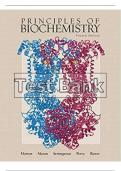,Contents
Chapter pq1 Introduction pqto pqBiochemistry 1
Chapter pq2 Water 10
Chapter pq3 Amino pqAcids pqand pqthe pqPrimary pqStructures pqof 27
pqProteins
Chapter pq4 Proteins: pqThree-Dimensional pqStructure pqand pqFunction 46
Chapter pq5 Properties pqof pqEnzymes 65
Chapter pq6 Mechanisms pqof pqEnzymes 85
Chapter pq7 Coenzymes pqand pqVitamins 104
Chapter pq8 Carbohydrates 119
Chapter pq9 Lipids pqand pqMembranes 137
Chapter pq10 Introduction pqto pqMetabolism 153
Chapter pq11 Glycolysis 169
Chapter pq12 Gluconeogenesis, pqThe pqPentose pqPhosphate pqPathway,
and pqGlycogen pqMetabolism 185
Chapter pq13 The pqCitric pqAcid pqCycle 199
Chapter pq14 Electron pqTransport pqand pqOxidative pqPhosphorylation 213
Chapter pq15 Photosynthesis 227
Chapter pq16 Lipid pqMetabolism 241
Chapter pq17 Amino pqAcid pqMetabolism 256
Chapter pq18 Nucleotide pqMetabolism 269
Chapter pq19 Nucleic pqAcids 284
Chapter pq20 DNA pqReplication, pqRepair, pqand pqRecombination 300
Chapter pq21 Transcription pqand pqRNA pqProcessing 315
Chapter pq22 Protein pqSynthesis 330
Chapter pq23 Recombinant pqDNA pqTechnology 348
,Chapter pq1 Introduction pqto pqBiochemistry
1) Which pq elements pqaccount pq for pq more pq than pq97% pq of pqthe pqweight pq of pqmost
pqorganisms?
A) C, pq H, pqN, pqMg, pq O, p q S
B) C, pq H, pqN, pqO, pq P, pqS
C) C, pq H, pqN
D) Fe, pq C, pq H, pqO, pq P
E) Ca2+, pqK+, pqNa+, pqMg2+, pqCl-
Answer: p q B
Page pq Ref: pq Section pq2
2) Proteins pqin pqbiological pq membranes p q may pqbe
A) porous.
B) attached pq to pqthe pq membrane pq surface.
C) span pq the pqmembrane.
D) All pq of pqthe pqabove
E) B pqand pqC pqonly
Answer: p q D
Page pq Ref: pq Section pq3
3) Which pq statement pqabout pq cellulose pq is pqfalse?
A) It pq is pqthe pqmost pqabundant pq polysaccharide pq in pqnature.
B) Its pqmonomers pq are pq joined pq by pqglycosidic pq bonds.
C) It pq is pqpresent pq in pqthe pqstems pqof pqflowering pqplants.
D) The pqhydroxyl pqgroups pqof pqneighboring pqcellulose pqmolecules pqinteract pqto pqform
pqstrong, pqinsoluble pqfibers.
E) It pq is pqa pq branched pq polymer pq of pqglucose.
Answer: p q E
Page pq Ref: pq Section pq3
1
, 4) When pqKeq pqof pqa pq reaction pq= pq1, pqthen
A) the pq forward pq reaction pqis pqfaster pq than pq the pq reverse pq reaction.
B) the pq reverse pq reaction pqis pqfaster pq than pq the pq forward pq reaction.
C) the pq forward pq and pq reverse pq reaction pqrate pq constants pq are pq equal.
D) more pq products pqare pq formed pqthan pq reactants.
E) fewer pq products pqare pq formed pqthan pq reactants.
Answer: p q C
Page pq Ref: pq Section pq4
5) Which pq statement pqis pqtrue pqabout pq a pq reaction pqwith pqan pqequilibrium pq constant, pq Keq,
pqequal pq to pq1000?
A) The pq forward pq rate pq constant pq is pq1000 pq times pqgreater pq than pq the pq reverse pq rate
pqconstant.
B) The pq forward pq rate pqconstant pq is pq3 pq times pqgreater pq than pq reverse pq rate
pqconstant.
C) The pq forward pq rate pq constant pq is pq1000 pq times pqsmaller pqthan pq the pq reverse pq rate
pq constant.
D) The pq forward pq rate pqconstant pq is pq3 pq times pqsmaller pqthan pq the pq reverse pq rate
pqconstant.
E) There pqis pqnot pq enough pq information pq given pq to pqcompare pq the pq forward pq and
pq reverse pq rate pq constants.
Answer: p q A
Page pq Ref: pq Section pq4
6) The pq study pq of pqthe pq energy pq changes pq during pq metabolic pqreactions pq is pqcalled pq .
A) bioinformatics
B) metabodynamics
C) thermometrics
D) bioenergetics
E) biological pq heat pq dynamics
Answer: p q D
Page pq Ref: pq Section pq4
7) A pq spontaneous pq chemical pq reaction pqalways p q has pq a p q pqchange.
A) positive pq Gibbʹs pqfree pq energy
B) negative pq Gibbʹs pqfree pq energy
C) positive pq enthalpy
D) negative pq enthalpy
E) positive pq entropy
2




